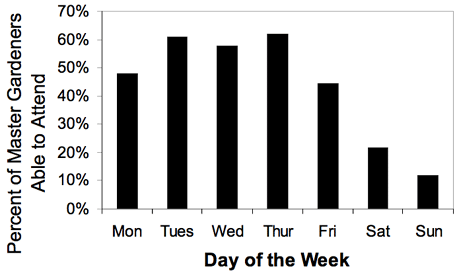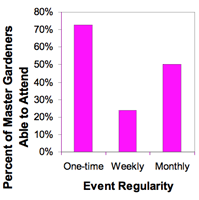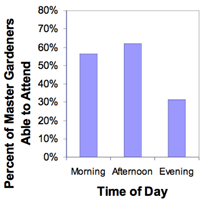December 2006 // Volume 44 // Number 6 // Research in Brief // 6RIB5
Continuing Education Interests of Master Gardener Volunteers: Beyond Basic Training
Abstract
Knowledge of client preferences is important when designing continuing education programs. Extension professionals surveyed 131 Master Gardener volunteers in El Paso County, Colorado to guide future programs. Results showed they are highly interested in continuing education events, especially in improving diagnostic skills. Master Gardeners are also interested in learning about local ecology, home gardening skills, and home landscapes through lectures, field trips, and hands-on activities. One-time or regular monthly events held on weekday mornings and afternoons are most popular, especially October through May. When these guidelines were used to design continuing education classes, actual attendance was similar to predicted attendance.
Introduction
Continuing education programs are an important component of vigorous Master Gardener programs. Cooperative Extension's high-quality educational programs recruit, retain, and motivate Master Gardener Volunteers.
In one study, Master Gardener applicants rated the opportunity to increase their knowledge as the main motivator for applying to the Master Gardener Program (Simonson & Pals, 1990). Missouri Master Gardeners ranked benefits related to increasing knowledge and understanding as the most highly valued benefits of the program (Schrock, Meyer, Ascher, & Snyder, 2000). Furthermore, Master Gardeners cited "learning new things" as the highest motivating force for both initiating and continuing service in Master Gardener Programs (Wolford, Cox, & Culp, 2001). Therefore, continuing education programs not only disseminate research-based information, but also motivate Master Gardeners to serve their communities on a continued basis through Cooperative Extension's program.
Designing continuing education programs can be a challenging task for Extension professionals. Many program managers desire to provide interesting and well-timed programs to their constituents. Yet, because their time is severely constrained, they are reluctant to carry out extensive needs assessments. In addition, questions concerning content and scheduling can also hinder efforts. Should continuing education programs reinforce or expand upon Master Gardener training? How should topics and preferences be prioritized? How can programs address the diverse interests, learning styles, and schedules of Master Gardeners? Despite these challenges, Extension professionals can quickly gather sufficient information with minimal effort through a simple self-administered survey.
In order to guide continuing education programming efforts in El Paso County, Colorado, horticulture Extension professionals surveyed 131 active Master Gardeners in the county. The study was designed to answer the following questions:
How interested are Master Gardeners in continuing education programs?
In what topics are Master Gardeners most interested?
Which educational format do Master Gardeners prefer?
When should Extension professionals offer continuing education programs?
The results from the study reported here were used to prioritize topics, program formats, and schedules for continuing education efforts in El Paso County. Much to our surprise, there were several interesting trends gleaned from the survey results, which may warrant further investigation at the state or regional level. If similar trends are found in other localities, Master Gardeners Coordinators may wish to modify existing basic training curricula, reorganize the way information is presented, or incorporate different educational approaches.
In addition, our results indicate that additional programming opportunities may exist outside the traditional focus of most Master Gardener programs. If additional research finds widespread interest in these topics, statewide or regional programming efforts could be justified.
Although the results presented in this article can only be directly applied to El Paso County, this example illustrates how client preferences gleaned from self-administered surveys can greatly assist the design of education programs.
Methodology
In October 2005, a two-page survey consisting of eight sections was given to active Master Gardeners and apprentices of El Paso County, Colorado. The term "active Master Gardener" includes volunteers who were initially accepted into the program, completed the basic training course, and completed 24 volunteer and 12 continuing education hours in the past year. The survey was administered during a quarterly informational meeting and sent by email or letter to absent Master Gardeners.
Three Extension staff members compiled lists of possible educational themes, topics, and formats to design the survey. Respondents were asked to rate each item within four sets topics, including series themes, subject matter, program formats, and class schedules. Ratings were based on a Likert-type scale from 5 (most interested) to 1 (less interested). If respondents were not interested in an item, they were instructed to not rate the item by leaving the answer line blank (scored as 0). We included space for respondents to provide additional ideas and comments. To indicate their availability, respondents were asked to check boxes next to the best time, day, month, and event regularity for their schedules.
Ninety-two Master Gardeners completed the survey out of 131 active Master Gardeners, for a 70% response rate. Seventy-three respondents completed the survey during the quarterly meeting, and 19 respondents completed the survey after the meeting.
Based on the survey results, a three-part series of continuing education classes was developed. Each of the three classes was presented during a day and night session from February to March 2006. Attendance was recorded.
Results
Master Gardeners showed strong interest in continuing education programs (Table 1). Eighty-one percent of respondents indicated high interest, suggesting that future continuing education programs would be well attended and highly valued. This result is not surprising because other studies reported educational opportunities as a prime motivator for Master Gardeners. However, measuring the interest of El Paso County Master Gardeners helped justify staff planning time, predict future attendance, and estimate program costs. Respondents who did not answer the question may have visually missed the question due to its formatting and location on the survey.
| Interest Level | Percentage of Respondents |
| Highly interested | 81% |
| Moderately interested | 11% |
| Not interested | 0% |
| No response | 8% |
Master Gardeners were most interested in learning about issues of local importance. Developing diagnostic skills was the highest-rated series theme (Table 2). Strong interest was also shown in sustainable landscaping as well as local flora and ecology, which may imply an interest in environmental stewardship. Home gardening skills was also highly ranked. In other localities, the set of topics listed in Table 2 could easily be modified to fit the environmental, cultural, and sociological conditions in which Master Gardener programs operate.
| Series Themes | Rank | High Interest | Medium Interest | No Interest | Median Response | Inter-Quartile Range |
| Diagnostic skills | 1 | 77% | 19% | 4% | 5 | 1 |
| Sustainable landscapes | 2 | 67% | 25% | 8% | 4 | 2 |
| Plant communities and ecology of the county | 3 | 61% | 30% | 9% | 4 | 2 |
| Home gardening skills | 4 | 61% | 29% | 10% | 4 | 3 |
| Specialty plants | 5 | 51% | 37% | 12% | 4 | 3 |
| Water conservation | 6 | 51% | 33% | 16% | 4 | 3.5 |
| Abiotic plant stresses | 7 | 47% | 41% | 12% | 3 | 2 |
| Plant science fundamentals | 8 | 48% | 36% | 16% | 3 | 3 |
| Horticulture and nutrition | 9 | 36% | 47% | 17% | 3 | 3 |
| Horticulture around the world | 10 | 25% | 51% | 24% | 2 | 2.5 |
Master Gardeners were most interested in learning about long-lived plants used in outdoor home landscapes. Volunteers demonstrated strong interest in perennials, native plants, shrubs, grasses, trees, and landscape design (Table 3). The popularity of native plants, rated second highest overall, again suggests a strong environmental stewardship ethic amongst Master Gardeners. Despite the large number of turf-related questions posed to volunteers by the public (typically 50% of phone inquiries), turf was rated as the least interesting subject.
| Subject Matter | Rank | High Interest | Medium Interest | No Interest | Median Response | Inter-Quartile Range |
| Perennials | 1 | 84% | 14% | 2% | 5 | 1 |
| Native plants | 2 | 76% | 13% | 11% | 5 | 1 |
| Shrubs | 3 | 68% | 20% | 12% | 4 | 2 |
| Grasses | 4 | 62% | 34% | 4% | 4 | 2 |
| Trees | 5 | 62% | 26% | 12% | 4 | 2.5 |
| Landscape design | 6 | 61% | 25% | 14% | 4 | 2 |
| Vegetables | 7 | 52% | 33% | 15% | 4 | 2 |
| Insects | 8 | 52% | 29% | 19% | 4 | 3 |
| Soils | 9 | 50% | 30% | 20% | 3.5 | 4 |
| Wildlife | 10 | 49% | 31% | 20% | 3 | 3 |
| Weeds | 11 | 45% | 38% | 17% | 3 | 3 |
| Plant communities | 12 | 45% | 29% | 26% | 3 | 4.5 |
| Irrigation | 13 | 40% | 39% | 21% | 3 | 3 |
| Fruits | 14 | 38% | 37% | 25% | 3 | 3.5 |
| Annuals | 15 | 37% | 43% | 20% | 3 | 3 |
| Houseplants | 16 | 30% | 48% | 22% | 3 | 3 |
| Specialty plants | 17 | 29% | 48% | 23% | 2 | 3 |
| Turf | 18 | 28% | 52% | 20% | 2 | 3 |
Master Gardeners were interested in a diversity of educational delivery methods. Lectures, presentations, field trips, and hands-on activities were all rated positively (Table 4). This suggests a variety of educational formats would be successful. However, small-group activities were not as well liked. Only one respondent suggested on-line delivery of information in the comments section.
| Format | Rank | High Interest | Medium Interest | No Interest | Median Response | Inter-Quartile Range |
| Lectures and presentations | 1 | 82% | 15% | 3% | 5 | 1 |
| Field trips | 2 | 71% | 28% | 1% | 4 | 2 |
| Hands-on activities | 3 | 70% | 24% | 6% | 4 | 2 |
| Small group projects | 4 | 40% | 40% | 20% | 3 | 3 |
The closer field trip destinations were to home, the more likely Master Gardeners were to attend (Table 5). Most Master Gardeners suggested day-trip destinations. The majority of respondents (67%) were not interested in out-of-state field trips.
| Field Trip Preferences | Rank | High Interest | Medium Interest | No Interest | Median Response | Inter-Quartile Range |
| Within El Paso County | 1 | 71% | 4% | 25% | 5 | 4.5 |
| In-state field trips | 2 | 51% | 10% | 39% | 4 | 5 |
| Out-of-state field trips | 3 | 12% | 21% | 67% | 0 | 1 |
The majority of Master Gardeners preferred to attend events during the week, with Tuesday, Wednesday, and Thursday as the top choices (Figure 1). Few Master Gardeners were willing to attend weekend events.
Figure 1.
Availability of Master
Gardeners to Attend Continuing Education Events by Weekday

Master Gardeners were available in spring, fall, and winter (Figure 2). The majority of respondents could attend events from October to May. Events held in summer months (June, July, and August) are not likely to be well attended.
Figure 2.
Availability of Master
Gardeners to Attend Continuing Education Events by Month

Master Gardeners preferred to attend one-time events (Figure 3). Half of the respondents were also interested in regular monthly events. Regular weekly events did not garner large support. Furthermore, most Master Gardeners preferred to attend events during the day, either in the morning or afternoon (Figure 4). Around one-third of volunteers were willing to attend evening events, but just eight people indicated that they could only attend evening events.
Figure 3.
Preferences for Event
Regularity

Figure 4.
Preferences for Event
Time
Based on the survey results, Extension professionals designed and offered three continuing education classes on Tuesdays and Wednesdays in February and March, 2006. Actual attendance agreed closely with the attendance projected from the survey. The classes were designed as a three-part series to improve diagnostic skills. Seventy-seven Master Gardeners (83% of survey respondents, or 59% of all El Paso County Master Gardeners) attended at least one class (Table 6). This figure corresponds closely to the 81% of respondents who indicated high interest in continuing education events.
It is worth noting that the survey results only reflected the preferences of the volunteers who completed the survey. It would have been incorrect to anticipate that 81% of all El Paso County Master Gardeners would attend continuing education events, because a non-random sampling technique was used. Because 30% of the original sample did not complete the survey, extrapolating the results to the entire sample would have led to significant non-response error.
| Attendance Category | Number of People |
| Attended at least 1 class | 77 |
| Attended all 3 classes | 37 |
| Attended 2 of 3 classes | 25 |
| Attended 1 of 3 classes | 11 |
From the survey results, we expected most Master Gardeners to attend the afternoon classes. This proved to be true. Despite the fact that one-third of Master Gardeners indicated they were willing to come to evening events, only eight to 12 people, or roughly the same number of people who said they could only attend evening classes, went to the nighttime option.
| Class Number | Time Offered | Number of Attendees |
| Class 1 | afternoon | 53 |
| Class 1 | evening | 8 |
| Class 2 | afternoon | 47 |
| Class 2 | evening | 12 |
| Class 3 | afternoon | 45 |
| Class 3 | evening | 11 |
Conclusions
Because Master Gardeners show strong interest in continuing education programs, providing such opportunities should be a high priority. The following points can be summarized from the survey results.
Continuing education programs should focus on diagnostic skills first, then local ecological and horticultural issues.
Programs should contain information on perennial plant components of home outdoor landscapes (perennials, native plants, shrubs, trees, ornamental grasses).
Environmental stewardship should be a central theme.
Volunteers prefer lectures, presentations, local field trips, and hands-on activities.
Programs should be scheduled from October to May as one-time events, and secondarily regular monthly events.
Most Master Gardeners prefer to attend events during mornings and afternoons, preferably on Tuesdays and Thursdays.
Continuing education classes in El Paso County, Colorado designed from these guidelines had similar actual attendance as predicted by the survey results.
In addition to serving as an example of a needs assessment approach for other Extension employees, the results from the study uncovered two interesting trends. First, Master Gardeners strongly communicated the need for additional, on-going training to strengthen their diagnostic skills. Identifying the cause of plant problems is a large part of their volunteer activities and is a difficult skill to master. In later discussions, many Master Gardeners felt that the basic training course did not adequately prepare them for this task. Master Gardener Coordinators may wish to consider reorganizing Master Gardener training with a similar approach as problem-based medical training. This approach introduces the ability to formulate and test a hypothesis during the instruction period. Medical educators have also improved the diagnostic skills of medical students by reorganizing educational concepts to aid diagnostic processes (Elstein & Schwartz, 2002).
Second, Master Gardeners displayed strong interest in ecological issues. In the study, Master Gardeners demonstrated equal interest in learning about local ecology and plant communities as home gardening skills. This suggests Master Gardeners have a broader scope of interest than home gardening. Extension professionals may wish to capitalize on this interest to address environmental sustainability and conservation issues in their communities.
Master Gardener interests are likely to be different in other counties. Conducting a formal needs assessment through a simple self-administered survey can greatly assist Extension professionals in developing relevant and well-attended programs.
References
Elstein, A. S., & Schwartz, A. (2002). Clinical problem solving and diagnostic decision making: selective review of the cognitive literature. BMJ, 324(7339), 729-732.
Schrock, D. S., Meyer, M., Ascher, P., & Snyder, M. (2000). Benefits and values of the Master Gardener program. Journal of Extension [On-line], 38(1). Available at: http://www.joe.org/joe/2000february/rb2.html
Simonson, D. L., & Pals, D. A. (1990). Master Gardeners: Views from the cabbage patch. Journal of Extension [On-line], 28(2). Available at: http://www.joe.org/joe/1990summer/rb3.html
Wolford, M., Cox, K., & Culp III, K. (2001). Effective motivators for Master Volunteer program development. Journal of Extension [On-line], 39(2). Available at: http://www.joe.org/joe/2001april/rb4.html
